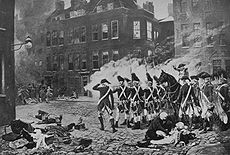On this day in 1780, London was rocked by the biggest and most dramatic riots in British history. There was more damage to property than Paris suffered during the French Revolution, leaving hundreds dead, hundreds more wounded, and dozens of buildings destroyed. The so-called Gordon Riots seriously dented England’s reputation, challenging the very notion of ‘democracy’, and would lead directly to the founding of Britain’s first police force.
So what sparked it?
Two years before, Parliament decided to repeal some harsh anti-Catholic legislation from the previous century and introduced the Catholic Relief Act of 1778. But the very idea of tolerating Catholicism was deeply resented in Protestant England. Lord George Gordon – a 29-year-old MP for Ludgershall in Wiltshire – was in no doubt that the Act had been cynically formulated “for the diabolical purpose of arming the Papists against the Protestant colonies in America.” In a series of rousing speeches and mass rallies, he incited the masses to uphold the cause of liberty and demand a return to the repression of Catholic absolutism.
On June 2nd 1780, Gordon led a crowd of over 60,000 to the House of Commons to present a petition stating that the legislation encouraged ‘popery’ and was a threat to the Church of England. The petition was rejected, and rioting broke out. The angry mob attacked anyone suspected of being Catholic, burned down churches, houses and destroyed businesses. Using their momentary advantage, the crowd then moved beyond its original anti-Catholic objectives to square accounts with the rich and other symbols of oppression. Visionary poet William Blake was swept up by a rampaging mob that stormed the legendary Newgate prison – walls were toppled, gates smashed and more than one hundred prisoners freed. Other prisons, aristocratic homes, embassies and chapels were attacked, plundered and burned before the crowd marched on the Bank of England.
For six days in London, the mob ruled. King George III eventually called in his army, who couldn’t legally fire until the Riot Act had been read. When the army finally managed a response, it did so with unfettered brutality – firing directly into any group of four or more who did not immediately disperse. Nearly three hundred were killed on the streets of London and another few hundred died subsequently of wounds received. Twenty-five of the ringleaders were sentenced to death, including a 14-year-old youth, though Gordon himself was found not guilty of treason.
The day after rioting broke out, the Earl of Shelburne shocked parliament by proposing that Britain should perhaps consider forming a force modelled on the French police. This was widely opposed on the grounds that it was totalitarian, “too French” and a symbol of “foreign oppression.” But the shockwaves in the wake of the Gordon Riots would not die down. Fifty years later, the Metropolitan Police Force was founded.
Today, any angry display of discontent is inflamed by heavy-handed police tactics, distorted by the media and loudly criticised by fence-sitting liberals. Recently, George Churchill-Coleman – former head of Scotland Yard’s anti-terrorist squad – expressed his opinion that Britain was moving in the direction of a police state, with biometric identity cards, mass surveillance and detention without trial all having been introduced or mooted. The UK has been described as “the most surveilled country” in the world, while protests within a half-mile radius of the Houses of Parliament are illegal unless authorised by the Metropolitan Police. Now might be a good time to remember why the idea of a police force was for so long rejected!



6 Responses to 2nd June 1780 – the Gordon Riots